The Islands of Flores and Corvo - Western Group of the Azores Archipelago
- Catarina Araújo

- Aug 28
- 17 min read
Updated: Sep 8

Flowers - The Pink Island
At the western end of the Azores archipelago — and of all Europe — lies the island of Flores, a piece of land measuring just 141.4 km² that is home to 3,428 inhabitants (2021 Census). Measuring 16.6 km long and 12.2 km wide at its widest point, this island shares the name Grupo Ocidental (Western Group) with its neighbour Corvo, located 17.9 km away. Its highest point, Morro Alto, reaches an altitude of 914 metres, offering breathtaking views of craters, lagoons and deep valleys.
The name ‘Flores’ comes from the abundance of colourful vegetation that covered the landscape, especially yellow flowers, and the island also earned the nickname ‘Pink Island’ in reference to the azaleas and hydrangeas that colour the paths and slopes. On Flores Island, the lush green vegetation blends with waterfalls cascading down cliffs, crater lakes and a rugged coastline of rare beauty.
Discovered by Portuguese navigators in the mid-15th century, Flores experienced difficult and late settlement, marked by failed Flemish attempts and only consolidated at the beginning of the 16th century. Since then, the island has been the scene of historical episodes linked to Atlantic navigation — from pirate attacks to whaling — but it has always retained its essence: a remote, wild territory deeply connected to nature.
Unlike all the other Azorean islands, which lie on the Eurasian plate or very close to the triple junction of the plates (Eurasian, African and North American), the islands of Flores and Corvo are clearly located on the North American plate.
Since 2009, Flores Island has been part of UNESCO's World Network of Biosphere Reserves. This classification allows the region's unique characteristics, such as its vegetation, flora and fauna, which enchant visitors, to remain untouched. Within the island, there are several specific protected areas that are part of the Flores Natural Park (created in 2008):
Morro Alto and Pico da Sé Nature Reserve (covers the central plateau, lagoons and peat bogs).
Natural Monument of the Caves and Algar do Pico do João Martins.
Protected areas for habitat or species management, such as coastal islets.
Special protection areas for birds (SPAs, under the Natura 2000 network).
Flores Island is an untouched garden in the Atlantic, a place where tranquillity, authenticity and natural beauty merge into an unforgettable setting.
Natural Landscape and Geosites
The 7 volcanic craters and their respective lagoons
On the central plateau of Flores Island, the seven lagoons form an ideal setting for travel photography. The lagoons are actually volcanic craters that resulted from hydromagmatic eruptions. With the end of volcanic activity, the craters remained as closed depressions, with no natural drainage to the sea. Over time, these cavities filled with rainwater and spring water, forming the current lagoons. The relative impermeability of the volcanic soil (with layers of compacted ash and tuff) helped to retain the water.
Some lagoons are permanent (such as Negra or Comprida), due to the constant accumulation of water. Others, such as Lagoa Seca, only fill up during periods of heavy rainfall, functioning as temporary reservoirs. Surrounded by peat bogs and endemic vegetation, these lagoons form a geosite of great scenic and ecological value.
Lagoa Negra (Caldeira Funda) – the deepest in the Azores, at around 110 metres, it owes its name to the dark colour of its waters, enhanced by its depth and the surrounding slopes.
Lagoa Comprida – located next to Negra, it contrasts with it due to its elongated shape and lighter shades, forming together one of the most iconic images of the island.
Lagoa Branca (Caldeira Branca)– surrounded by a ring of volcanic tuffs, it has clearer waters and is a prime spot for observing migratory and resident birds.
Lagoa Funda – although less deep than Negra, it retains its grandeur and is surrounded by lush vegetation that reinforces its serene atmosphere.
Lagoa Rasa – located at higher altitudes, it offers sweeping views over the central plateau, complementing the Negro-Comprida complex with another perspective.
Lagoa da Lomba – more isolated, in the eastern part of the island, it is the only one in the group where visitors can get significantly close to the shore.
Lagoa Seca – it is distinguished by being usually dry, filling only during periods of heavy rainfall, when it becomes a temporary refuge for migratory birds.
The Lagoas Negra, Comprida, Seca and Branca lagoons form one of the most emblematic geosites in the Azores Geopark. Classified as an area of high scientific and scenic value, this geosite is part of the Morro Alto and Pico da Sé Nature Reserve. In addition to its scenic beauty, the site is of great ecological importance, serving as a refuge for migratory birds and a natural freshwater reservoir.
The best-known spot for admiring these lagoons is the Miradouro das Lagoas viewpoint, which offers the famous view of the two lagoons: Lagoa Negra next to Lagoa Comprida. The viewpoint is also part of the PR3 FLO – Miradouro das Lagoas – Poço do Bacalhau walking trail, which connects the central plateau to the waterfalls of Fajã Grande, providing a complete experience from the mountainous interior to the coast.
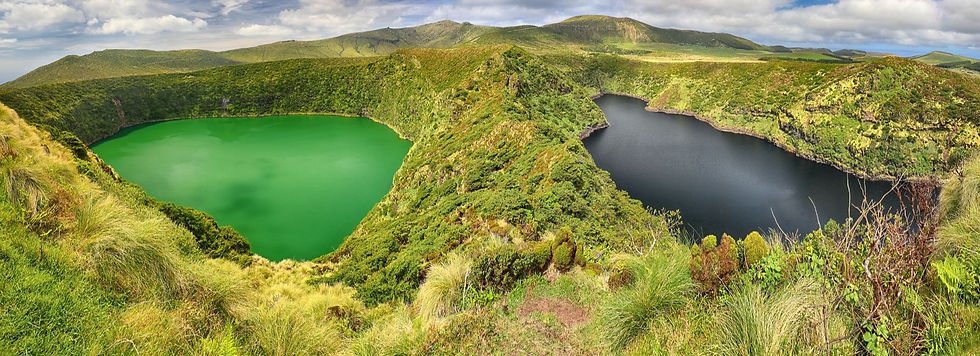
This cluster of craters reveals the unique interaction between water and volcanic activity, making it one of the island's natural landmarks and one of the highlights of any visit to Flores.
Peatlands of the Central Plateau
The central plateau of Flores Island is one of the most unique areas of the archipelago, where altitude and high rainfall have created an ecosystem of great ecological value. The landscape is marked by extensive peat bogs, which act as natural sponges, regulating the water cycle and feeding springs and streams that cascade down to the coast. Among the carpets of moss and peat are patches of cedar, a species endemic to the Azores that reinforces the unique character of this habitat.
Formed mainly by the growth of sphagnum moss, peat bogs accumulate plant matter over thousands of years without complete decomposition, thanks to the permanently humid environment. With a high water retention capacity, these ecosystems are fundamental to the island's landscape: they ensure the existence of lagoons and the flow of streams that feed the famous waterfalls.
The Flores Peat Bog is considered the largest and best preserved in Europe. In addition to its role in water management, it also has global environmental value, functioning as an important carbon sink and helping to mitigate the effects of climate change. Walking across the plateau is therefore like immersing yourself in a territory where nature reveals itself in delicate balance — between lagoons, peat bogs and endemic forests that make Flores a truly unique island.
Waterfalls
The abundance of rainfall and the mountainous terrain have given rise to dozens of waterfalls, many of them tens of metres high, transforming the landscape into a true natural spectacle.ral.
Poço da Ribeira do Ferreiro (the island's landmark)
Also known as Poço da Alagoinha or Lagoa das Patas, this magical place is formed by a cliff covered with lush vegetation, from which more than 20 waterfalls descend simultaneously, accumulating in a serene lagoon and creating a natural setting of rare beauty.
The site is part of the Morro Alto Forest Reserve, an environmentally protected area that preserves both endemic vegetation and wildlife. The name ‘Lagoa das Patas’ (Paw Lagoon) comes from the frequent presence of wild ducks, especially during the migration season.
Access: The access trail, approximately 700 metres long (20 to 30 minutes on foot), is short but has uneven ground and a slight incline. At the end, visitors are rewarded with a view of the lagoon and waterfalls, in an atmosphere of absolute tranquillity.
Tip: visiting in the late afternoon is particularly special, as the position of the sun illuminates the green wall and waterfalls, revealing vibrant hues and offering an even more magical experience.
Poço do Bacalhau
Located in Fajã Grande, it is one of the highest waterfalls on the island, at around 90 metres. The waterfall ends in a natural pool where, on hot days, you can take a refreshing dip. The site is easily accessible and one of the most photographed on the island.
Access: Short walk from the Fajã Grande road; the trail is easy and safe, suitable for families.
Ribeira Grande Waterfall
The highest waterfall in Flores, at approximately 180 metres, creating a mist that seems to hang in the air. Less accessible and further from the road, it stands out for its impressive verticality. The waterfall is visible from several viewpoints along the walking trail that connects Fajã Grande to Lagedo.
Along the coast in the Fajã Grande area, there are several waterfalls that cascade down the island's green cliffs, falling directly into the sea. From the Fajã Grande bathing area, you can admire this landscape while swimming in the sea, creating an unforgettable moment.el.
The Flores waterfalls are a beautiful sight resulting from the combination of mountainous terrain, an Atlantic climate and an abundance of water.
Florentine Coastline
The coast of Flores is marked by contrasts: vertiginous cliffs that seem to rise directly from the sea, sheltered coves where small fajãs (flat areas) are hidden, and a succession of sea caves that give the coastline a jagged and dramatic character. On calm days, the black lava reveals a rich seabed, making the island a prime destination for diving and marine life observation.
Geosite of the Santa Cruz Coast
In the Santa Cruz area, the coastal landscape is deeply sculpted: rocky headlands, coves and natural pools coexist with the marks of ancient volcanic activity.
The Boqueirão Environmental Interpretation Centre, housed in a former whaling factory, continues this connection between land and sea, highlighting marine biodiversity, migratory birds and cetaceans that frequent these waters.
Morro dos Frades
To the north of Santa Cruz stands Morro dos Frades, a curious rock formation in which popular imagination sees the silhouettes of a friar and a nun.
Monchique Islet
Moving towards the Atlantic, the Monchique Islet marks the westernmost point of Europe. This black rock, standing alone in the ocean, has been a navigational reference point for centuries for sailors crossing the North Atlantic. Looking at the islet from the Ponta Negra lookout or the Albernaz lighthouse, you feel like you are at the ‘end of Europe’, contemplating the beginning of the vast ocean.
Geosite of Fajã Grande and Fajãzinha
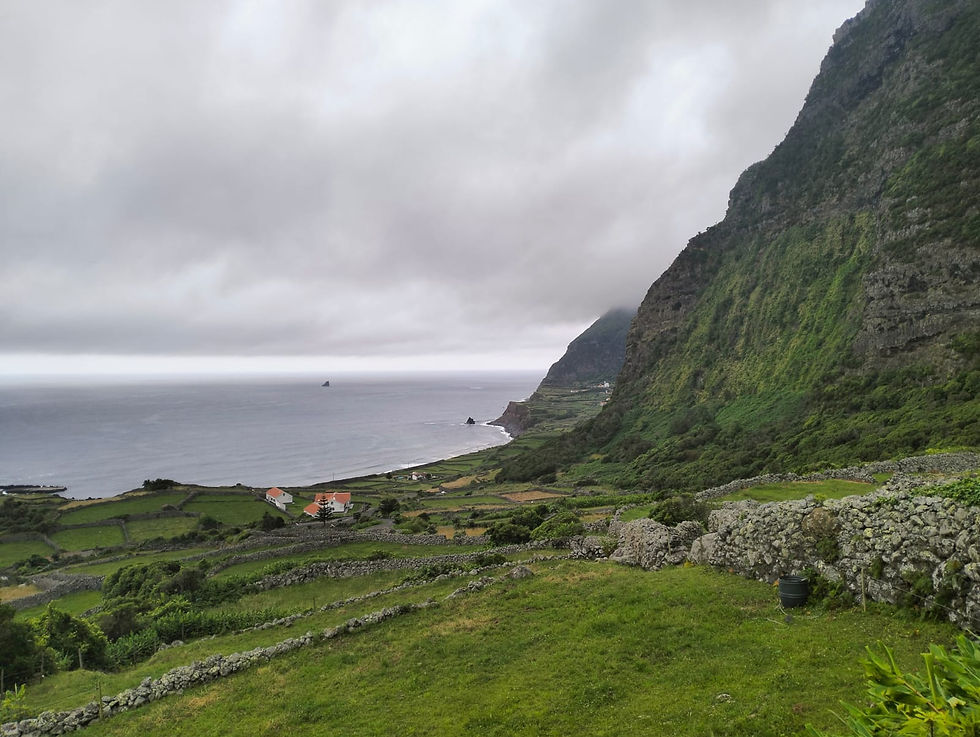
On the western side of the island, Fajã Grande and Fajãzinha make up one of the most impressive coastal landscapes in the Azores. The fossil cliff, about 300 metres high, is furrowed by almost two dozen waterfalls, including Ribeira Grande, which stands out as one of the largest waterfalls on the island. In addition to their geology and nature, these fajãs are home to picturesque villages, notably Aldeia da Cuada, which has now been restored for rural tourism.
Fajã Grande Bathing Area
This is one of the most popular spots on the island during the bathing season. With grassy banks, benches and picnic tables, a pleasant restaurant with a terrace, among other facilities, it has become one of the region's landmarks.
Fajã de Lopo Vaz: memory of the village
On the south coast, Fajã de Lopo Vaz stands out as one of the first places to be inhabited on the island. Access is via a footpath that descends the cliff to a small paradise with an almost tropical microclimate, where agricultural species such as banana trees and vines grow. At the foot of the cliff, a spring of drinking water and a black sand and pebble beach complete the scene. This geosite is also a living testimony to the geological instability of the cliffs, as the nearby Ponta da Rocha Alta gave rise to a fajã in 1985 after a landslide.
Between imposing cliffs and serene fajãs, the coast of Flores reminds us that here the land and sea live in an eternal dialogue of beauty and mystery.
Unique Natural Formations
Among the icons of the Florentine landscape, the Rocha dos Bordões stands out, an impressive formation of prismatic basalt columns, the result of the slow cooling of an ancient lava flow. Rising like a huge stone organ on the southwestern slope of the island, it is considered one of the most striking images of Flores.
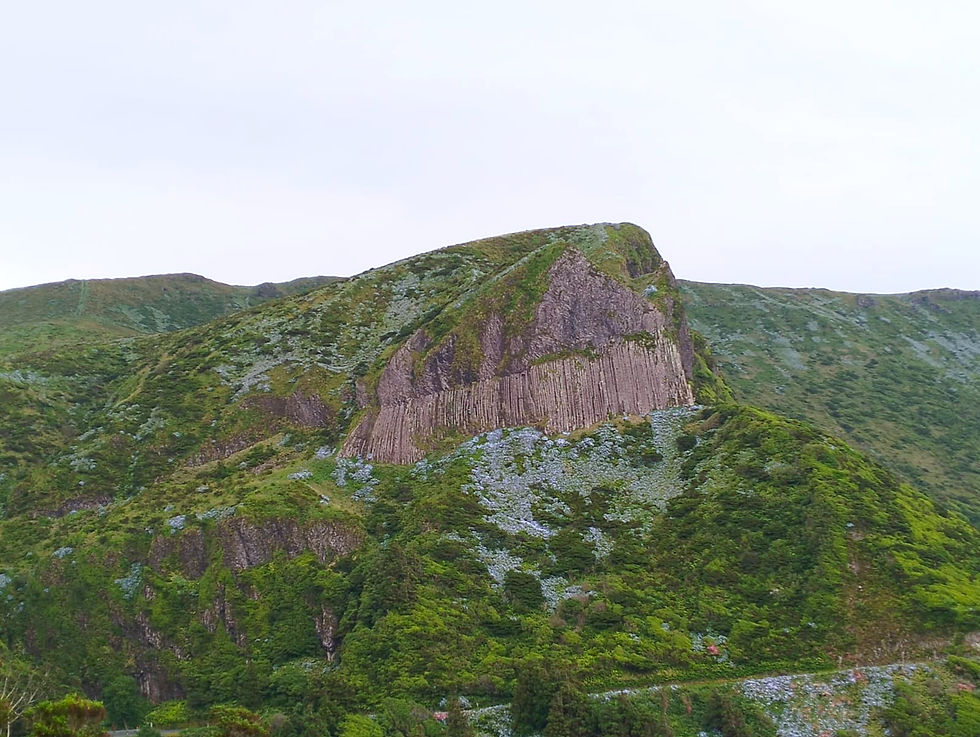
These unique natural formations reveal the geological force that shaped the island of Flores and invite you to explore the beauty and symbolism of Europe's westernmost point.
Viewpoints
The island of Flores has several strategically located viewpoints, allowing visitors to appreciate the grandeur of its landscapes, from fajãs and waterfalls to ocean views and unique rock formations.
Portal Viewpoint
📍 Location: Fajãzinha / Lajes das Flores
From the Portal Viewpoint, you can see Fajãzinha and part of Fajã Grande, lava fajãs formed by the accumulation of sediments carried by the streams and ravines of the fossil cliff. This cliff, about 300 metres high, is marked by numerous waterfalls that descend towards the sea, creating one of the most beautiful coastal geoscapes in the Azores.
Ponta Delgada Viewpoint
📍 Location: Ponta Delgada / Santa Cruz das Flores
From the top of this viewpoint, you can see the parish of Ponta Delgada and, on clear days, the neighbouring island of Corvo.
Fajã do Conde Viewpoint
📍 Location: Caveira / Lajes das Flores
Located on the east coast of the island, it offers views over Fajã do Conde and the parish of Caveira, an area classified for its ecological and landscape importance.
Rocha dos Bordões Viewpoint
📍 Location: Rocha dos Bordões / Lajes das Flores

A privileged spot to contemplate the emblematic Rocha dos Bordões, an impressive formation of basalt columns resulting from the slow cooling of lava. One of the greatest natural icons of the island of Flores.
Craveiro Lopes Viewpoint
📍 Location: Fajãzinha / Lajes das Flores
It allows you to appreciate the grandeur of the fossil cliff with its waterfalls, Fajãzinha, Poço da Alagoinha and even the islet of Monchique. One of the most complete panoramas of the island.
Fajãzinha Viewpoint
📍 Location: Fajãzinha / Lajes das Flores
View over the parish of Fajãzinha, located on a lava fajã formed by ancient lava flows in contact with the sea. A peaceful spot, framed by green hillsides.
Pico Alto Viewpoint
📍 Location: Achada - Lajes das Flores
From this viewpoint, located at the highest point of Flores and situated in the Morro Alto and Pico da Sé Nature Reserve, you can see the entire island, including the volcanic formation known as Testa da Igreja, as well as Pico da Sé.
Each viewpoint offers a different perspective of the island, making them essential stops for understanding the geological uniqueness and natural beauty of Flores.
Heritage and Culture
The Parish of Mosteiro
Mosteiro is the smallest parish in the Azores in terms of population, with only a few dozen inhabitants. Of ancient origin, its name is said to have come from the resemblance of large rocks to the towers of a monastic building. Among the cultivated fields and white houses that stand out against the green landscape, stands the Church of the Holy Trinity, built in the mid-19th century thanks to funding from the adventurer António de Freitas, a native of the island who made his fortune in Macau.
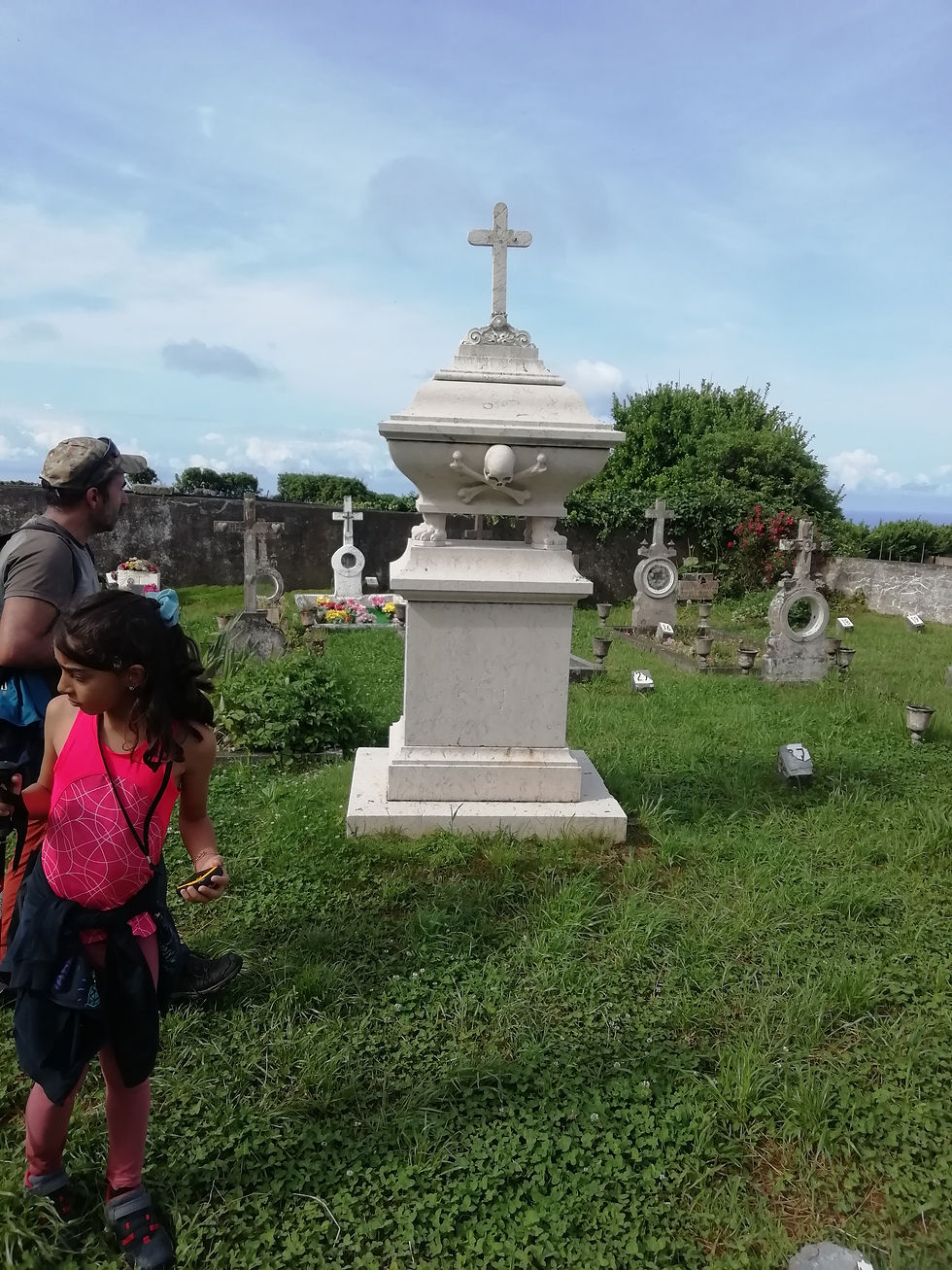
Interestingly, António de Freitas' story is intertwined with episodes of piracy and opium trafficking. His grave, located in the cemetery next to the church, is still shrouded in mystery and legend, making it one of the most intriguing elements of the parish.
Caldeira do Mosteiro
Caldeira do Mosteiro preserves the memory of a small village that is now abandoned. This settlement, isolated by the rugged terrain of the island's western coast, was for centuries a testament to the resilience of rural communities that lived off the land and sheep farming.
The village was gradually abandoned due to the harsh living conditions, with its last inhabitant leaving in 1992. Some inhabitants moved to the monastery, where there was already electricity and running water, while others emigrated to the United States.
The village of Caldeira do Mosteiro, located in a volcanic caldera with a small stream winding its way between the houses, is a magical place that will be given a new lease of life through a new eco-resort project that aims to restore the old houses and barns.
Azenha da Fajãzinha
Built in 1862, the Azenha da Fajãzinha (Fajãzinha Windmill), also known as Moinho da Alagoa (Alagoa Mill), is powered by the waters of the Alagoa River. The space remains in operation thanks to the work of miller Fátima Serpa, who continues to grind corn using traditional methods and distribute flour to various parts of the island.
Visits to the mill are possible on weekdays between 1 p.m. and 5 p.m., offering not only the opportunity to learn about this traditional art up close, but also a privileged view of the impressive Ribeira Grande waterfall, which is 180 metres high.
Albernaz Lighthouse

The Ponta do Albernaz Lighthouse, inaugurated in 1925, is the oldest lighthouse in the Azores still in operation and also the westernmost in Europe. It stands on a high cliff at the northwestern tip of the island of Flores, with a 15-metre-high white cylindrical tower and red lantern, whose light reaches up to 41 km.
Built facing the sea routes that crossed the Atlantic, it was for decades a crucial point of orientation for navigation. Today, it remains active and can be visited through guided tours by the resident lighthouse keeper, an opportunity to understand the functioning and importance of this type of structure.
Its privileged location offers one of the most expansive panoramic views of the island: to the west, the islet of Monchique — the westernmost point of Europe — and to the north, the neighbouring island of Corvo. In addition to the landscape, it is also an excellent spot for bird watching, as many migratory species find their first stopping point here when arriving in Flores.
It is also worth extending your visit to the parish of Ponta Delgada, just 3 km away, a village with centuries of history linked to the sea and rural life.
Experiences and Adventures on Flores Island
Walking Trails
The island is criss-crossed by several Short Distance Walking Trails (PR) and also part of the Long Distance Walking Trail (GR01 – Flores/Corvo), offering scenery ranging from dramatic cliffs to fajãs and lagoons.
PR1 FLO – Fajã Grande / Ponta Delgada, along the west coast – is closed for safety reasons (landslides), so you should avoid it.
PR2 FLO – Lajedo / Fajã Grande, known for its waterfalls;
PR3 FLO – Miradouro das Lagoas / Poço do Bacalhau, ideal for viewing several lagoons;
PR4 FLO – Fajã de Lopo Vaz - the only land access to the fajã, one of the first populated areas on the island. The trail includes an old stone staircase.
These trails are well signposted and are the best way to experience the intense nature of Flores.
👉 In July 2026, we will return to Flores Island and Corvo on a special trip. We only have three vacancies available – if you want to experience this adventure, get in touch with us!
Gastronomy

Florentine cuisine reflects centuries of isolation and ingenuity. Pork in brine, cooked with potatoes and cabbage, recalls winter times when the sea was too rough for fishing. Other typical dishes include:
Yam with sausage
Watercress soup
Seaweed pies (omelette with seaweed)
Oven-roasted albacore
Conger eel stew
The cured cheese from Flores is a local speciality, as are the araçá sweets and honey with the aroma of the island's abundant flowers.
Where to Eat
Santa Cruz das Flores: Moreão (fresh fish and fish soup), Fora d’horas (quick, home-style meals), Queijaria Val da Fazenda, restaurant at the Hotel Ocidental.
Fajã Grande: Papadiamandis (sunset view), Maresia (gastronomic experience without a menu, in a family atmosphere), Aldeia da Cuada (part of rural accommodation).
Fajãzinha: Pôr do Sol Restaurant, Pico Redondo Cheese Shop.
Lajes das Flores: Casa dos Reis (organic products, cash only), O Forno Transmontano, Pastelaria Rosa (Florentine cheesecakes).
Where to Stay
Accommodation options range from hotels in Santa Cruz, such as the Hotel Ocidental, to rural tourism houses and local lodgings scattered across the island. Aldeia da Cuada, in Fajã Grande, is one of the most iconic locations, restoring an abandoned village in the 1960s and transforming it into a charming space.
Boat Trips
Exploring the coastline from the sea is one of the most memorable experiences. The tours allow you to see cliffs, waterfalls and caves that are inaccessible by land. The Gruta dos Enxaréus is one of the highlights, a huge cave that can be visited by boat.
Practical Travel Tips
Wear water shoes in natural pools or at beaches.
Be careful of jellyfish and Portuguese man-of-war.
Jellyfish sting: do not scratch, do not wash with fresh water or alcohol; wash with sea water.
Portuguese man-of-war sting: seek medical attention.
In some places there are strong currents: avoid taking risks by diving.
Exploring Flores Island is like diving into an authentic territory, where nature sets the pace and daily life is intertwined with centuries-old traditions. Whether you are walking along trails that reveal breathtaking landscapes, savouring cuisine influenced by the sea and the land, or simply watching the sunset over the Atlantic, each experience becomes an unforgettable memory.
Corvo - The Black Island
Corvo Island is often called the “Black Island” due to its dark volcanic rocks, the result of its geological origins. It is the smallest island in the Azores, with a landscape marked by black basalt, which contrasts with the vegetation and the Caldeirão Lagoon in the interior.
With an area of only 17.1 km² and around 400 inhabitants (2021 Census), Corvo is the smallest of the Azores islands and one of the most unique. Discovered around 1452 by Diogo de Teive, it was initially named Insula Corvi, in reference to the numerous cormorants sighted there. Together with Flores, it forms the Western Group of the archipelago.
Despite its small size, Corvo has its own identity, marked by frequent isolation in bad weather and the resilience of its community.
Natural Landscape
The island's landmark is Caldeirão, the vast crater of the ancient central volcano, which is about 300 metres deep. Inside, a shallow lagoon is home to small volcanic cones, which many say reproduce the map of the Azores in miniature.
The coastline is marked by steep and inaccessible cliffs, with the exception of the southern area, where Vila Nova do Corvo is located. Other notable features include Morro dos Homens (718 m), Morro do Pão de Açúcar, Monte Grosso (770 m) and the rock formations of Cavaleiro and Marco.
The island is also a landmark for migratory bird watching, serving as the first stop in the Atlantic for species coming from America and Europe.
Culture and Heritage
The only settlement on the island, Vila Nova do Corvo, sits on a lava fajã. The basalt houses with white trim and the cobbled streets give it a unique atmosphere. Even today, the tradition of wooden locks remains, a symbol of trust and closeness between neighbours.
Points of interest:
Church of Our Lady of Miracles, patron saint of the island, with a Flemish image of the Virgin and Child.
Corvo Museum and Interpretation Centre, which preserves the history and heritage of the community.
The windmills of Alto dos Moinhos, inspired by the Mediterranean, are different from those found elsewhere in the Azores.
The people of Corvo are proud of their history of resistance: in 1587 they faced the sacking of English privateers, and in 1632 the community managed to repel an attempted landing by Algerian pirates.
Experiences and Adventures
Walking trails: from the village centre to Caldeirão, climbing steadily between hydrangeas and stone walls, with breathtaking views from the Monte Gordo viewpoint.
Boat trips: sailing around the island reveals sea caves and cliffs and allows you to spot birds, dolphins and even whales.
Gastronomy: typical dishes such as calhau herb pies, couves da barça (cabbage), fried cabbage and Corvo artisan cheese.
Hospitality: on Corvo, everyone knows each other, and the experience of staying in small houses or guesthouses is marked by closeness and community sharing.
Useful Information
How to get there: inter-island flights (only 15 minutes between Flores and Corvo).
By sea: seasonal boat connections between Santa Cruz das Flores and Vila Nova do Corvo.
Visiting time: it can be explored in one day, but a longer stay allows you to fully experience the slow and authentic pace of the island.
Conclusion
Visiting Flores and Corvo is like stepping into one of the most authentic corners of the Atlantic. On Flores Island, nature displays all its power — imposing waterfalls, hidden lagoons, fajãs shaped by time.
On Corvo, the small size of the island contrasts with the grandeur of its identity: a resilient community, a dormant volcano transformed into a lagoon, and a pace of life marked by simplicity and human closeness.
Among the flower-lined paths and basalt walls, amid the sound of water and the flight of migratory birds, you discover that these islands are not just destinations — they are experiences that transform your outlook and remain in your memory.
And in the end, when you return, you take with you not only the landscape, but also the rare feeling of having touched the untouched heart of the Azores.
👉 In July 2026, we will return to Flores Island and Corvo on a special trip. We only have three vacancies available – if you want to experience this adventure, get in touch with us!
To Take in Your Luggage: Inspirational Reading
If you want to prolong your journey through the stories and legends linked to Corvo and Flores, two works deserve a place in your luggage:
The Revenge – Lord Alfred Tennyson - An epic poem inspired by the battle between the English galleon Revenge, commanded by Sir Richard Grenville, and the Spanish armada in 1591, off the coast of the Azores. A short but intense read, evoking courage, resilience and the weight of destiny.
The Knight of Raven Island- A historical novel that recovers the memory of a remote island and its inhabitants, intertwining reality and legend. The narrative transports us to the harsh but dignified daily life of the Corvina community, and to the almost mythical deeds that marked its identity.






























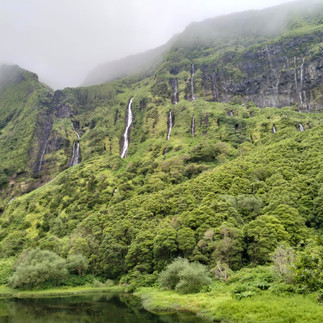













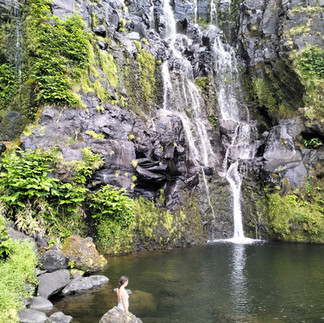





















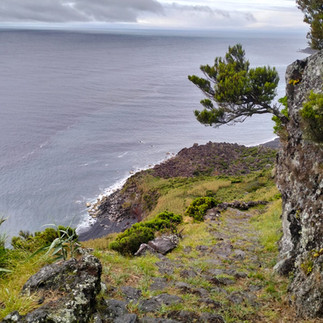















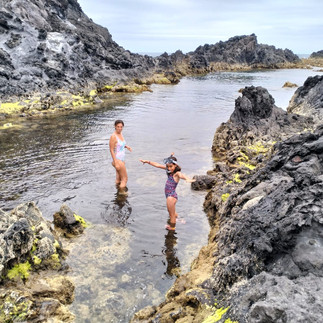



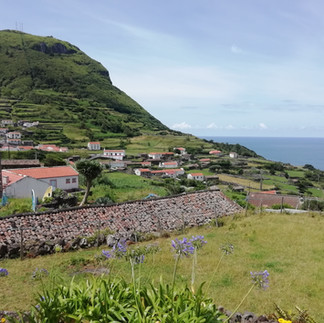





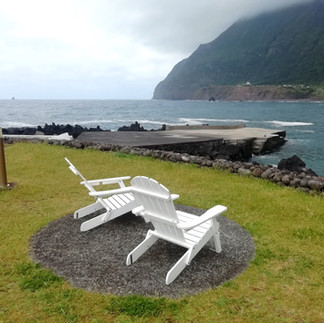

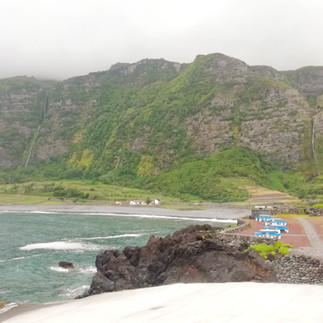







































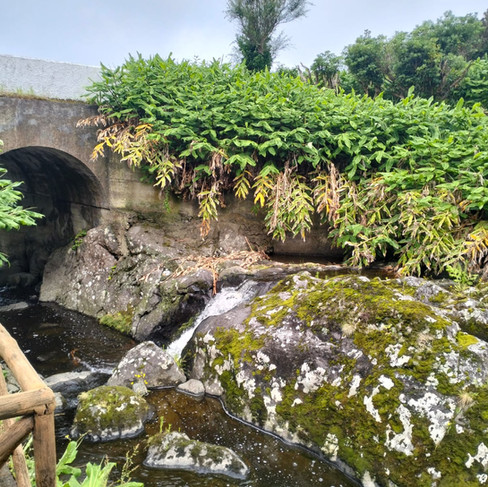



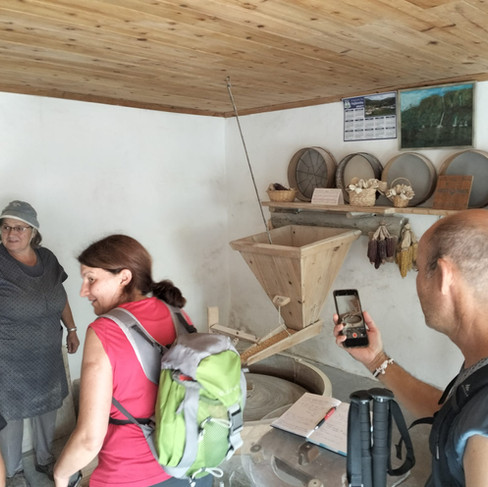

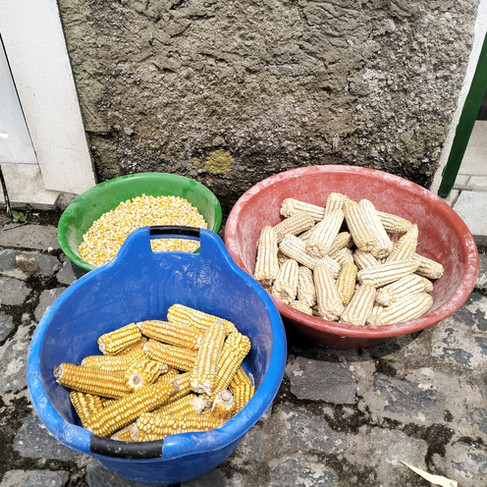





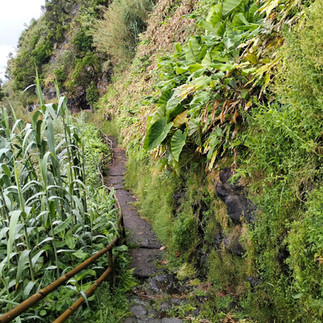












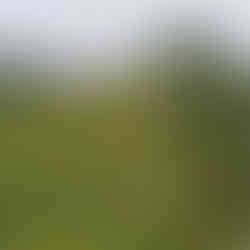










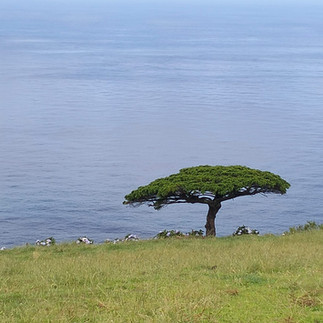














































Comments